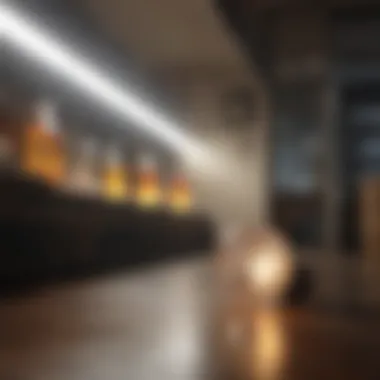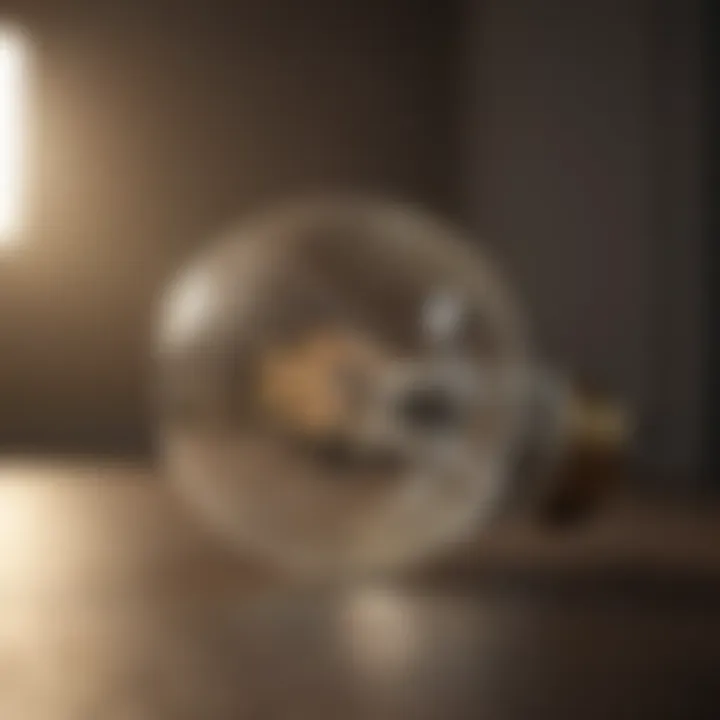LED Daylight Bulbs: Evolution, Benefits, and Future


Intro
Lighting is something we often take for granted, but it plays a crucial role in our lives. From setting the mood in our homes to enhancing the functionality of spaces, the type of bulbs we use can impact how we feel and how well we see. Amongst the various options available, LED daylight bulbs have emerged as a favorite, transforming how we approach illumination.
These bulbs mimic natural daylight, providing a bright and inviting glow while also being energy efficient. This topic is particularly important in the home improvement industry as homeowners are increasingly seeking sustainable and cost-effective solutions.
Understanding LED daylight bulbs isn't just about knowing what they are; it involves exploring their development, technology, and sustainability—all while considering the implications for our homes and lives.
Importance of the topic
As our awareness of environmental issues grows, so does the demand for lighting solutions that are both energy-efficient and sustainable. LED bulbs provide a significant leap forward from their incandescent predecessors, offering longer lifespans and lower energy consumption. By integrating these bulbs into our homes, we not only save money on utility bills but also contribute to a greener planet. Moreover, knowing the science behind these bulbs can help us make informed choices that benefit our well-being and enhance our living spaces.
Foreword to LED Daylight Bulbs
The advent of LED daylight bulbs represents a significant step in the journey of lighting technology. These bulbs not only illuminate spaces but also enhance the quality of light we experience on a daily basis. This piece will delve into what makes LED daylight bulbs unique, their benefits, and the considerations for anyone looking to switch from traditional lighting methods.
Definition and Characteristics
LED daylight bulbs are a modern approach to artificial lighting, engineered to mimic the natural sunlight we crave. What sets them apart is their color temperature, typically measured in Kelvin, that ranges from 5000K to 6500K. This range is recognized for producing a bright, crisp light that invigorates spaces, making them favorable in work environments and homes alike. Unlike their incandescent predecessors, LED bulbs are energy efficient and have a longer lifespan, offering an effective solution for reducing energy bills.
A clear characteristic is their durability. LED bulbs can withstand bumps and knocks better than fragile glass bulbs, and they emit little to no heat during operation. This means they extend the usability in varying conditions. Moreover, many LED daylight bulbs are dimmable, providing versatility in how one can set the ambiance in their home.
Historical Context of Lighting Technology
To appreciate where LED daylight bulbs fit in, a look back at the history of lighting is essential. The journey began with the humble candle and evolved into gas lamps, swiftly moving through to the electric incandescent bulb introduced by Thomas Edison in the late 19th century. Each leap brought improvements, yet the light produced was often inefficient and unsustainable.
With natural progression, fluorescent lighting arrived in the 20th century, boasting longer lifespans and greater efficiency than incandescent bulbs. However, many found fluorescent lights unappealing due to their harsh and cold quality. Thus, the arrival of LED technology in the early 2000s was a breath of fresh air. Researchers discovered how to utilize semiconductors to create light, leading to a rapid adoption of LED bulbs across various sectors, advancing not only home lighting but also industrial applications.
The rise of LED daylight bulbs marks a turning point—they provide a sustainable, efficient, and appealing illumination option. This rapid evolution reflects a societal shift towards smarter, more eco-friendly living and the increasing demand for lighting that harmonizes with our natural rhythms.
"As lighting technology continues to advance, LED daylight bulbs are not just a trend, but a fundamental shift towards sustainability and quality of life."
Overall, the introduction of LED daylight bulbs symbolizes a collective aspiration for better, more efficient lighting solutions, shaping modern spaces in a way that speaks to both practicality and aesthetics.
The Science of LEDs
Understanding the science behind LEDs is crucial not just for lighting enthusiasts, but also for homeowners and anyone looking to make informed choices about their lighting options. LED bulbs offer a multitude of benefits over traditional lighting solutions, making them a compelling choice as we navigate the complexities of modern home energy use. When one delves into how LEDs function, one uncovers a narrative that intertwines energy efficiency and ecological awareness, both of which are increasingly relevant in today’s world.
How LED Technology Works
LED stands for Light Emitting Diode. At its core, an LED is a semiconductor device that converts electricity directly into light. This process is known as electroluminescence. The heart of an LED bulb consists of a chip made of materials like gallium, arsenide, and phosphorous. When electricity flows through the chip, it energizes the electrons, causing them to emit photons – the particles of light. This simple yet effective mechanism is far more efficient than the incandescents, which produce light through heating a filament to a high temperature. Simply put, more energy is utilized in generating light rather than heat.


One of the standout features of LED technology is its durability. Unlike fragile incandescent bulbs that can break easily, LEDs are robust and are designed to withstand bumps and vibrations, making them ideal for various settings in a household. Additionally, LED bulbs last significantly longer – averaging about 25,000 to 50,000 hours compared to the 1,000 hours typical of incandescents.
Daylight Spectrum and Color Temperature
Daylight bulbs are designed to reflect the quality and brightness of natural sunlight. When discussing color temperature, it refers to the warmth or coolness of the light emitted, measured in Kelvins (K). Generally, daylight LED bulbs range from 5000K to 6500K, mimicking the hues of daylight. This spectrum not only enhances visibility but also uplifts mood, making spaces feel more lively.
"The right lighting can change the whole ambiance of a room, almost like changing the color of the walls."
In practical terms, having a daylight spectrum can positively influence activities ranging from working in home offices to relaxing in family spaces. It’s identified that exposure to higher color temperatures can improve alertness and productivity. That said, each environment may call for different lighting tones, and homeowners should think about how color temperature plays into their overall design and functional needs.
Comparison with Incandescent and Fluorescent Bulbs
When comparing LEDs to traditional lighting options, the differences become glaringly clear:
- Energy Efficiency: LEDs consume significantly less power (about 75% less) than incandescent bulbs. This not only leads to lower energy bills but also contributes to reduced greenhouse gas emissions.
- Lifespan: As mentioned, while incandescent bulbs last approximately 1,000 hours and fluorescents around 7,000 to 15,000 hours, LEDs take the cake with their extensive lifespan of 25,000 hours or even more.
- Heat Emission: Incandescent bulbs release about 90% of their energy as heat, whereas LEDs generate very little heat, making them safer and more efficient.
- Color Options: LEDs come in a wide spectrum of colors, making them versatile for both functional and decorative applications. Incandescents are often limited to warm white hues, while fluorescents can sometimes produce an unpleasant glare.
- Environmental Impact: LEDs are considerably environmentally friendly, being free from hazardous materials like mercury that are present in fluorescent lights. Thus, their disposal poses less of a risk to the environment.
When switching to LED technology, homeowners not only make a better choice for their pocket but also contribute to a more sustainable future. In sum, the science of LEDs offers a blend of economic and ecological benefits that cannot be overlooked.
Energy Efficiency
In today’s fast-paced world, every penny counts, especially when it comes to household expenses. Energy efficiency plays a pivotal role in this financial landscape, particularly in the context of LED daylight bulbs. These bulbs are not just a trend; they represent a significant leap forward in lighting technology, merging cost-effectiveness with sustainability. By integrating LED bulbs into homes, housewives and homeowners can achieve notable savings on their energy bills while addressing contemporary environmental concerns.
Understanding Energy Consumption
When considering energy usage, it’s essential to understand how different lighting solutions measure up against each other. LEDs are known for their superior energy efficiency, consuming significantly less power than traditional incandescent and fluorescent bulbs. To put it plainly, an LED bulb can produce the same amount of light (measured in lumens) as a 60-watt incandescent bulb while only using about 8 to 12 watts. This not only reduces electricity costs but also lessens the demand on power plants, contributing to a cleaner environment.
"Switching to LED bulbs can reduce energy consumption by up to 80% over traditional lighting."
Consider this: if a household uses ten bulbs and each bulb lasts about 25,000 hours, the savings add up rapidly. Not only will the monthly power bill shrink, but overheads stemming from frequent bulb replacements, commonly required for less durable options, can also be minimized. This reallocation of funds enables homeowners to invest in other areas of interest or necessity.
Cost-Benefits Analysis
When the initial prices of LED bulbs are presented, some may think they hit harder on the wallet. However, a deeper analysis shows that the long-term benefits far outweigh the initial investment. Here’s a rough breakdown of costs and savings:
- Initial Cost: A single LED bulb typically costs between $5 and $15, depending on its features.
- Lifespan: Average lifespan of an LED bulb is around 25,000 hours, compared to 1,000 hours for an incandescent bulb.
- Energy Cost Savings: Depending on energy prices (let's say if electricity costs around $0.12 per kWh), switching ten bulbs to LED could save approximately $100 annually.
In the grand scheme, these compare favorably to the shorter lifespans and greater energy consumption of traditional lighting options. It becomes evident that the initial higher price of an LED bulb is a drop in the bucket when considering the reduction in energy bills and replacement costs over time.
Environmental Impact
Beyond personal savings, energy efficiency via LED technology has wider implications for society and the planet. With concerns about climate change looming larger than life, the shift to energy-efficient solutions has never been more necessary. LEDs contribute to lower carbon footprints, significantly when adopted on a wide scale.


- Reduced Greenhouse Emissions: Because LEDs consume less energy, less power is needed from fossil-fuel powered plants. Consequently, this leads to a reduction in greenhouse gas emissions.
- Longer-lasting Bulbs Mean Less Waste: Traditional bulbs frequent the trash, filling landfills quickly. Switching to LEDs means fewer bulbs will end up as waste.
In essence, every little bit counts. Whether it’s financial savings for the household or a broader contribution to environmental health, choosing energy-efficient lighting solutions is a step in the right direction for both homeowners and society as a whole.
Health Implications
The realm of lighting, particularly with the advent of LED daylight bulbs, extends beyond aesthetics and utility. Understanding health implications is paramount because light fundamentally influences our well-being. Embracing LED technology not only aligns with energy efficiency and sustainability but also offers significant benefits for our health. This section examines how artificial light interacts with our bodies, the potential effects on our physiology, and how these considerations can guide better lighting choices in home environments.
Effects of Light on Human Physiology
When discussing how light affects us, we have to take a look at its role in regulating several physiological processes. Light influences hormones, mood, and even sleep patterns. For instance, exposure to blue light, commonly emitted by LED bulbs, plays a critical role in the production of melatonin – a hormone that controls sleep-wake cycles. Understanding this relationship is vital for maintaining a productive and healthy lifestyle.
- Mood Enhancement: Proper lighting can lift spirits. Studies show that exposure to natural light enhances serotonin levels, the neurotransmitter responsible for feelings of happiness. In turn, LEDs designed to mimic daylight can provide similar benefits in environments lacking sufficient sunlight.
- Vision and Eye Health: While LEDs have longevity and energy efficiency, concerns arise about potential eyestrain. The sharp brightness and blue light might lead to discomfort for prolonged exposure. It's crucial to ensure that lighting is not overly harsh, which can hamper productivity and comfort in homes.
- Safety and Functionality: Adequate lighting in common areas reduces the risk of accidents. Poorly lit spaces can lead to trip hazards, especially for the elderly. Therefore, the proper application of LED fixtures that cast even, bright light can substantially increase safety, allowing peace of mind when moving around one’s home at night.
"Light is the first of painters. There is no object so dull that it will not reflect some light."
— Louis Kahn
Circadian Rhythms and Artificial Lighting
Circadian rhythms dictate our internal biological clock, influencing sleep patterns and daily functioning. The disruption of these cycles can result in various health issues, including fatigue, mood disorders, and decreased overall performance. This is where the transition to LED daylight bulbs reflects both significance and concern.
The ability of light to affect circadian rhythms lies in its intensity and spectral composition. Here’s how the switch to LED lighting can impact our daily lives:
- Balanced Light Exposure: LEDs can be designed to emit different spectra throughout the day. In the morning, brighter, cooler blue light can help reset and energize our circadian rhythms. Conversely, dimmer, warmer light in the evening signals the body it's time to wind down.
- Artificial Lighting Adjustments: With smart LED bulbs, homeowners can adjust light settings to align with natural light patterns, contributing to better sleep quality. This can be especially helpful during winter months when natural light is scarce.
- Health Consequences of Disruption: Poorly managed lighting can lead to chronic sleep deprivation and mental health issues, underscoring the need for homeowners to be mindful of their lighting choices.
In summary, the implications of LED daylight bulbs on health are multifaceted, ranging from enhancing mood through adequate exposure to light, to maintaining circadian rhythms for optimal well-being. As awareness grows, understanding these elements can pave the way for healthier living environments.
Market Trends and Consumer Perspectives
Understanding market trends and consumer perspectives on LED daylight bulbs is pivotal in discerning their impact in the broader lighting industry. The rise of LED technology is not just attributed to its efficiency; it reflects shifting consumer behavior, preferences, and a growing awareness of sustainability. As housewives and homeowners increasingly prioritize energy-efficient solutions that align with environmental consciousness, LED bulbs have become a frontrunner in household lighting.
Consumer Adoption of LED Technology
The adoption of LED technology has surged across households; it is hard to ignore the advantages these bulbs provide.
- Energy Efficiency: Compared to traditional incandescent bulbs, LEDs use significantly less energy, which leads to noticeable savings on electricity bills. Many families are now seeking out these financial benefits.
- Longevity: LEDs are designed to last significantly longer—often up to 25,000 hours—which translates to fewer replacements. This feature is particularly attractive to busy homeowners who prefer low-maintenance options.
- Versatility in Applications: They come in various shapes and sizes, making them suitable for myriad lighting setups—from indoor use to outdoor garden fixtures.
However, it is not just about functionality. The visibility of LED bulbs in retail spaces and the increasing variety accessible to consumers have made them a part of daily shopping decisions. Television advertisements and online campaigns amplify this awareness, influencing how people perceive their importance in modern life.
Misconceptions about LED Bulbs


Despite the clear benefits, several misconceptions persist among consumers regarding LED daylight bulbs, which can hinder their broader acceptance:
- LEDs are too expensive: Many still believe that the initial purchase price of LED bulbs is exorbitant. While it's true that they tend to be pricier than traditional options upfront, shoppers must consider the long-term savings in energy costs and durability.
- LEDs provide harsh light: There’s a perception that LEDs are glaring and unflattering compared to incandescent lighting. However, advancements in technology have led to a variety of color temperatures, enabling consumers to select softer, warmer tones that replicate the inviting atmosphere of older lighting types.
- Dimming compatibility: Consumers often assume that all LED bulbs can’t be used with dimmer switches, which is incorrect. Many modern LEDs are designed for compatibility with existing dimming systems, enabling flexible lighting solutions.
"Understanding these misconceptions is key for consumers to make informed choices, ultimately benefiting both their households and the environment."
Future of Lighting Solutions
The future of lighting solutions is paramount, especially when tracing the evolutionary path of LED daylight bulbs. Current trends indicate a distinct shift in how people perceive and utilize light in their daily lives. This transformation is not just about switching bulbs but embodies a broader mindset towards energy efficiency, sustainability, and enhanced living spaces. With the growing reliance on technology, integrating lighting systems with smart technology is becoming increasingly vital, bringing forth several benefits that cater specifically to household needs.
Innovations in LED Technology
Recent advancements in LED technology are re-shaping the lighting industry. One remarkable innovation is the development of tunable white LEDs. This technology allows homeowners to adjust the color temperature of their bulbs, ranging from warm to cool light, all at the touch of a button. For instance, during the day, a cooler light mimics natural sunlight, enhancing focus and activity. In the evening, you can switch to a warmer hue, creating a cozier and relaxing atmosphere. This ability to customize lighting can significantly impact mood and productivity.
Furthermore, OLED (Organic Light Emitting Diodes) technology is gaining traction. OLED panels are thinner, flexible, and emit light uniformly, making them apt for various applications, especially in interior design, where aesthetics play a crucial role. Households are beginning to see these innovations reflected in smart devices—integrating LEDs into furniture, mirrors, and other household items for both functionality and style.
"Innovations in LED technology not only enhance luminescence but also pave the way for eco-friendly solutions that replace the bulky and inefficient traditional lighting."
Lastly, the focus is shifting towards energy harvesting systems. This technology captures energy from movements, light, or even temperature differences to power LED fixtures. A practical example is underfoot generators that convert the pressure from footsteps into usable energy for lighting. Such developments push the boundaries of conventional lighting and create pathways to a sustainable future
The Shift Toward Smart Lighting
The shift toward smart lighting represents a significant change in how households light their environments. Smart lighting systems offer more than just illumination; they provide control and connectivity that many homeowners find appealing.
- Integration with Smart Home Systems: Today, many lighting solutions come with the ability to connect to home automation systems. Integrating with platforms like Amazon Alexa or Google Home means householders can control their lights with simple voice commands – turning them on or off, adjusting brightness, or changing colors without lifting a finger.
- Energy Monitoring: Smart lighting solutions frequently include built-in energy monitoring features. This allows homeowners to track their energy usage in real-time and make necessary adjustments. For example, you might discover that your evening habit of leaving lights on can be mitigated by setting timers or utilizing motion sensors.
- Customization and Scheduling: With smart lighting, it’s about tailoring illumination based on time or activity. Households can set schedules for their lights, meaning they can wake up to gradually brightening lights or come home to a well-lit environment without manually switching anything on.
This newfound convenience cannot be understated. Not only do smart lighting solutions cater to aesthetic preferences, but they also complement lifestyle choices, fostering an environment that adapts to daily rhythms.
End
The energy sector has undergone significant transformations over the years, particularly in the realm of lighting. LED daylight bulbs stand at the forefront of this evolution. Their importance, as outlined throughout this article, goes beyond mere illumination. They signify a shift towards sustainability and efficiency in our everyday lives.
Summary of Findings and Insights
From understanding the mechanics behind LED technology to acknowledging its superior benefits over traditional incandescent and fluorescent options, it’s clear that LED daylight bulbs offer a wealth of advantages. These bulbs consume considerably less energy, which translates to lower electricity bills. Moreover, they have a far longer lifespan, reducing the frequency of replacements.
In addition to these practical benefits, our exploration highlighted the potential health implications associated with lighting. Bright light, particularly at certain times of the day, can affect our circadian rhythms, an essential factor for maintaining overall well-being. These insights permit us to create environments that enhance our quality of life at home.
Interestingly, consumer adoption trends indicate a burgeoning awareness and shift in perception regarding LED technology. Although some misconceptions about brightness and quality persist, more homeowners and housewives are opting for these energy-efficient options, striving for better choices for both their homes and the environment.
Final Thoughts on LED Daylight Bulbs
In light of everything discussed, LED daylight bulbs are not simply a fad; they represent a sustainable choice for the future. Homeowners should realize that by transitioning to these lighting solutions, they’re participating in a broader movement towards environmental responsibility.
The practical implications of LED bulbs are compelling: they save money, reduce energy consumption, and contribute to healthier living spaces. Moreover, as manufacturers innovate and improve these technologies, we can expect even more reliable and captivating options to become available.
Ultimately, adopting LED daylight bulbs is a win-win for homeowners seeking to illuminate their spaces sustainably and efficiently. Let’s embrace this evolution in lighting; it’s not just a step towards progress but a leap towards creating a more sustainable future for generations to come.







